As we made the short walk to the terminal, Meryl was captivated in the same way Rex and I were with the incessant activity in the docks. From our position in our berth we could observe not only all yachts entering our marina, but also spot vessels of all manner of sizes and functions passing through to the inner harbours. Many of the vessels served the oil and gas fields, but there were dozens of naval warships, survey ships, coast guard vessels, tugs, lighters and coastal vessels. These operated non-stop during the day in such profusion that it came as no surprise that the harbour master needed to be consulted over VHF before leaving or entering the harbour.
 Gull Escort |
Hordes of children stood by the side rails shouting and waving to families and friends on shore, who in turn roared back, waving frantically. Rex commented that there was more of a fanfare at this departure than what he'd seen and heard on the departure of a cruise ship.
Flocks of gulls hovered around the ship as it left the land, and it seemed to be a tradition to hold pieces of bread out for the birds. The gulls gracefully glided along at same speed as the boat, and snatched the morsels. I was amazed at how effortlessly these birds could closely track the vessel on the wing - a bird photographer's paradise.
It was a short crossing to Texel, and as we alighted at 't Horntje, we bumped along in the happy throng of noisy, excited children, getting knocked by rucksacks and clipped by cycles. Most of the youngsters were off to camp and to visit the seal sanctuary. Once on shore, we joined a queue of folk of all ages and sizes, waiting to hire cycles. Several options were available: single gear, multi-gear, tandem, trailer bikes, electric bikes, in fact everything but unicycles and penny-farthings. Whilst Rex watched the world go by from a seat, Meryl and I got chatting to a woman in front of us in the queue. She spoke perfect English, but was Dutch by birth, hailing from Alkmaar. She told us how she had spent the last 42 years in Calgary, Alberta. The woman didn't look particularly old, and we wondered if she had gone abroad when she was quite young. Her parents, a friendly couple who spoke mainly Dutch, were clearly looking forward to their cycle ride with their daughter.
 Meryl and Rex Burning the Rubber |
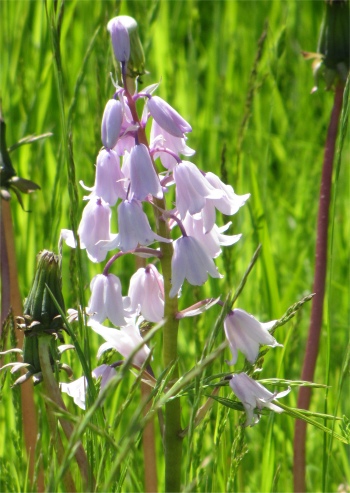 Just One of a Host of Wild Flowers |
Texel was a part of the former coastal barrier, which was smashed to pieces and separated from the mainland by storms and floods in the twelfth century, forming the present Waddenzee (Wadden Sea) and the row of islands. But as the other islands were mainly shaped by wind and water and consist of sand and dunes, enlarged by its inhabitants with polders as a result of the diking of salt marshes in later years, Texel's history goes back much further. Even as far as the prehistory, the Saalien period to be precise, the second-last glacial period in this region that lasted from 200,000 till 130,000 years B.C. During this period the arctic ice was covering roughly half of the present territory of the Netherlands. In various places you can still see the ranges of hills that were pushed up by the tremendous force of the glaciers moving on. Since then, these heights consisting of boulder clay have been prominent landmarks in the flat and marshy scenery. They withstood the ravages of time, while the surrounding land was constantly changing under the influence of wind and water.
As early as at the end of the fourteenth century the "Rede van Texel" (Texel Roads) already was a household word. It was the place where the sea-going sailing ships anchored, awaiting favourable winds to bring them to their destination. In the fifteenth and sixteenth century those destinations were mainly in the Baltic region, but after the establishment of the VOC (Vereenigde Oostindische Compagnie - Dutch United East Asia Company) in 1602, Texel became the starting point of almost every journey to the Dutch East Indies. In 1415 the island as a whole was granted privileges of a town and since then Texel is, in the matter of surface area, the largest town in the Netherlands.
Texel also became the place where the ships took in the drinking-water needed for their long journey. The wells on the island produced water of an exceptional good quality that would keep for a long time, because of its high iron content, a tremendous advantage, as the trip to the East Indies might take six to twelve months. The drinking-water, often more than 100,000 litres for a single ship, was transported in casks by little boats to the ships lying in the roadstead.
 Typical Rural House |
As well as the flocks of sheep surrounding us, the strips of land flanking the cycle path were awash with wild flowers: buttercups by the thousand, bluebells, campanula, poppies, cow parsley, cornflowers, and wild roses, all a pleasure to behold.
Long pelotons of children, all shouting and laughing, streamed down the "Fietspad" (cycle path) on the other side of the road to the ferry terminal. Other isolated groups passed along the way and diverted off across the vast network of cycle paths that traversed the island. Far away across the meadows, other long pelotons could be seen pelting along to unseen destinations. No prizes for guessing the favoured form of transport on this, and indeed all, Frisian or Wadden Islands.
We were graced with sunshine and gentle warmth on our ride, a rare treat, with a wisp of a breeze wafting in from the northeast to cool us down during our pedal. "I haven't been on a bike for 37 years," shouted Rex. Who was he trying to kid? I later discovered this two-wheeled aficionado had, during that period, cycled in Hungary and Croatia. After 8km, we entered the town of Den Burg, the "capital" of Texel, and with a population of nearly 7,000 by far the most important place.
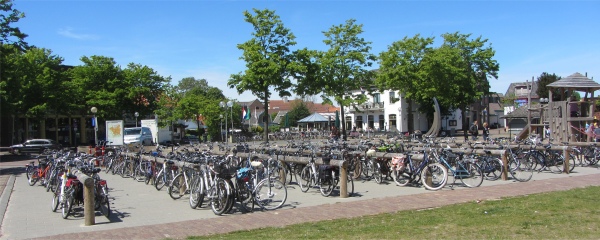 One of the Den Burg's Many Bike Parks |
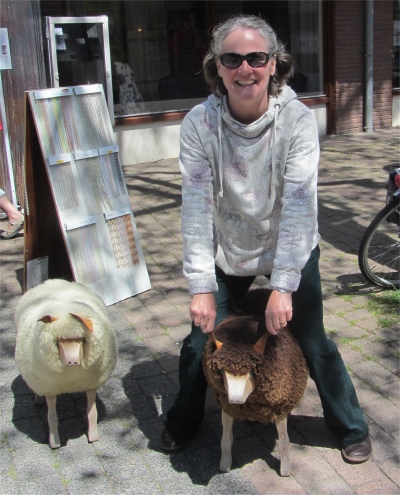 Meryl Choosing a New Saddle |
We picked our way into this charming town, and after parking our bikes, within minutes we were sitting in the sun sipping coffee and sampling appeltaart, a must do recommended by Yvonne. It was delicious, loaded with cinnamon, and served with a week's worth of cholesterol loaded whipped cream, extremely bad for us but heavenly.
The centre of the town was awash with upmarket clothes shops, which somehow held a magnetic attraction over Meryl; funny that. Bakeries, cafes, restaurants, craft shops and what I'd call junk shops abounded, and it was teeming with people.
We stumbled across a small, delightful museum on Kogerstraat, the "Oudheidkamer" or Museum of Antiquities. A good humoured old lady with a ready smile greeted us and charged us in guilders! She obviously hadn't caught up with euros yet. The museum was the smallest museum on Texel and illustrated the way of life of the islanders. The Oudheidkamer was built in 1599 as a guest house. Above the door a very old sign read, "Whoever stops his ears to the cry of the poor, God will not show him mercy". But it did have ears for the poor, even offered them shelter. People who were temporarily homeless and foreigners were allowed three free night's stay at the guesthouse. In later times, the house served as a regular house. Since 1954 it was used as a museum. It was decorated with all kinds of art and everyday objects, most from the 19th century.
This museum gave a fascinating insight into the island's history and contained artefacts for the period 17th - 20th century. The Oudheidkamer gave access to the smallest public herb garden in the Netherlands. Fully enclosed between walls and buildings could be found more than a hundred different species of plants and shrubs. The garden was only 70 square metres and exuded a serene calm. The pride of the garden was umbelliferous alexanders, the oldest Dutch wild herb, used in soup in former times. The herb disappeared in 1781, but was rediscovered in 1944 by Jac.P. Thijsse. Less known herbal species as chervil, colchicum and agrimony stood beside the everyday sage, chives, mint etc.
 "Oudheidkamer" or Museum of Antiquities |
In the so-called upper room folk stored their best possessions such as showpieces, brought from distant lands. The room served as a reception area for visitors, and in a way reminded me of parlours, familiar to me as a child in Cumbria. There was also a built in bedstead, and nearby the so-called spin or pantry. In the bedstead on the plank base, a child's crib stood. On the table lay a beautiful tea set. Tea was introduced during the seventeenth century, and became a whole ritual, for which a beautiful service was indispensable.
The kitchen included granite countertops, a fireplace and cooking utensils. Cooking was performed over the open fire, food cooked usually being casseroles. Running water came out of the pump. Shelves contained pottery and tins made of copper. The kitchen contained two old cabinets. A display case showed other special tableware pieces, and in the pantry various weighing scales and a very old cookbook were on show.
In the attic, an exhibition showed bathers and beach life on Texel between 1920 and 1950. There were old ladies and men's swimsuits, film images, attributes and many pictures. Meryl commented how she could remember her grandparents wearing such kit. How was it possible to swim in such knitted swimsuits?
The cellar, the coolest place in the house, served as a storehouse. Descending the steep steps we found the winter stock stand. Rows of canning jars stood, filled with vegetables, and earthenware pots lined up, used for storing in salt or vinegar. In the niche, a slightly cooler area, stood the brine tank full of salt stock.
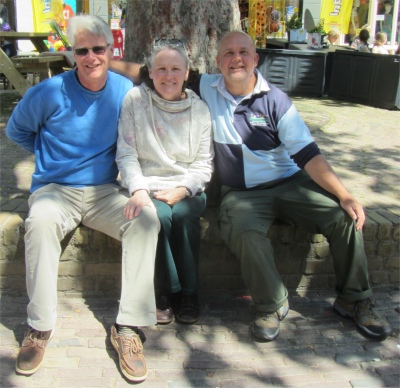 The Trio Relaxing in a Den Burg Square |
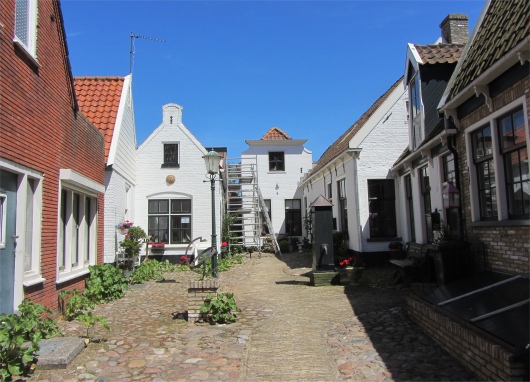 Picturesque Courtyard in Weverstraat |
Another 5km stint brought us to Den Hoorn, the most southern village on Texel and with a population of only 965 the second-smallest of the island. But once times were different. In the seventeenth and the eighteenth century the village was considerably larger and much more important, as there were many pilots living here. Piloting the VOC ships returning from their long journeys through the treacherous waters around Texel was one of the major livelihoods on the island. Residents of Den Hoorn stood on top of a nearby high dune, watching for ships that might require a pilot, and because they saw such ships generally earlier than their rivals from Oudeschild, they often had the advantage. The dune, standing at over 24m, the highest on Texel, is still mentioned "Loodsmansduin" (Pilot's Dune) to this very day.
The outstanding white little church of Den Hoorn has a 15th-century church bell still hanging in the tower, although it was confiscated by the German occupying forces in 1944 to be melted down for the purpose of arms industry, as happened with almost all churches in the Netherlands at that time. The bell was shipped with 200 others by boat, but the Dutch skipper intently sank his ship near the island of Urk. After the end of the war the bells were recovered and so Den Hoorn got its church bell back. The curious situation of the church, on the edge of the village and not in the center as usual, can be explained by the fact that Den Hoorn was much larger in earlier days. By then the church was in the village center, but when pilotage stopped being a major source of income in the nineteenth century, many residents moved away, leaving their houses empty. The houses were demolished and that's how the church became standing completely detached in the scenery.
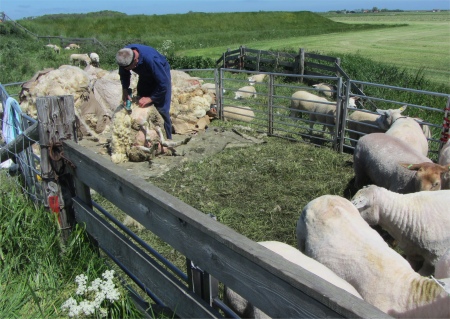 Sheep Shearer on the Way to Den Hoorn |
From Den Hoorn, we headed east, passing by houses in the small settlement with fascinating sculptures in their gardens. The western coast of all the islands consisted primarily of ranges of dunes sloping down to beaches of hour-glass sand. Polders were built towards the Waddenzee sides of the islands. Our cycle path took us through tunnels of trees surrounded by carpets of bluebells, into open country and then into a land of never ending dunes. Suddenly we found we were cycling up hills as the path weaved its way over dune after dune. The endless dunes brought on the onset of boredom, so we retreated back to Den Hoorn, and from there took cycle paths that led us through deserted flatlands back to the ferry terminal at 't Horntje. We'd had 5 hours of cycling and sight-seeing, and had covered well over 20km. It had been thoroughly enjoyable, and it had been a delight to explore a section of the island in truly Dutch fashion, on a cycle.
Later in the day, I watched a yacht entering the marina. Its ensign at the back hung limply, but I recognised black, yellow and red stripes, the colours of the German flag, so I shouted "Guten abend!" across to the crew. It was then that Meryl pointed out that it was actually a Belgium ensign; the same colours but vertical stripes as opposed to horizontal stripes. Can't win 'em all. Evening was a mix of washing and ship-cooked food, followed by an early night. The cycle ride had whacked some of us out, and on top of that poor Meryl had acquired a painful throat, probably a leftover from her flight.
